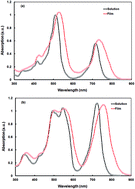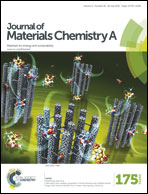CuSCN as selective contact in solution-processed small-molecule organic solar cells leads to over 7% efficient porphyrin-based device†
Abstract
Two conjugated acceptor–π–donor–π–acceptor (A–π–D–π–A) small molecules with a zinc porphyrin donor core and 3-ethylrhodanine terminal acceptors connected at the meso positions by ethynylene groups and linked by one or two thienylenevinylene units denoted by 1a and 1b were synthesized and their optical and electrochemical properties were investigated. Bulk heterojunction organic solar cells fabricated with 1a : PC71BM and 1b : PC71BM processed with THF exhibited power conversion efficiencies of 2.75% (Jsc = 7.96 mA cm−2, Voc = 0.96 V and FF = 0.36) and 3.18% (Jsc = 8.84 mA cm−2, Voc = 0.90 V and FF = 0.40), respectively. Moreover, organic solar cells based on 1a : PC71BM and 1b : PC71BM processed with pyridine/THF solution displayed PCEs of 5.27% (Jsc = 10.61 mA cm−2, Voc = 0.92 V and FF = 0.54) and 5.78% (Jsc = 11.58 mA cm−2, Voc = 0.86 V and FF = 0.58), respectively. However, most important is the observation that the PCE was further increased to 7.24% for devices based on 1a : PC71BM and 1b : PC71BM active layers processed with pyridine/THF solution by employing CuSCN as a selective contact electrode instead of the most common hole transport material, namely, PEDOT:PSS.


 Please wait while we load your content...
Please wait while we load your content...